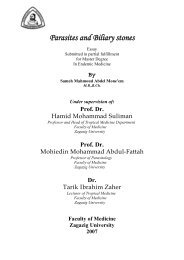J.'.~"";i'
J.'.~"";i'
J.'.~"";i'
Create successful ePaper yourself
Turn your PDF publications into a flip-book with our unique Google optimized e-Paper software.
Review ofLiterature<br />
small vessels of placental bed initiates acute atherosis and related<br />
thrombosis in maternal uterine spiral arteries leading to insufficient<br />
perfusion ofthe placental bed and the clinical symptoms of Preeclampisa<br />
(Wang et al., 1998).<br />
A report of a family with two cases of severe Preeclampisa<br />
/eclampsia in which very high levels ofLp(a) has been found, suggests<br />
that a very high Lp(a) level could be one risk factor for Preeclampisa that<br />
is genetically determined (Husby et al., 1996).<br />
However, Dijurovic et al., (1997) made an examination of 154<br />
women with Preeclampisa (Preeclampisa group) and 76 healthy pregnant<br />
normotensive women (control group) .The Preeclampisa group was<br />
further dvided into the following subgroups: mild Preeclampisa, severe<br />
Preeclampisa and Preeclampisa with fetal growth retardation. They found<br />
that plasma levels ofLp(a) were lower in the total Preeclamptic group as<br />
well as in all ofthe Preeelampisa subgroups than in the control group as<br />
determined by quantitative electroimmunoassay (Dijurovic et al., 1997).<br />
Leerink et al. (1997) in the same year studied levels ofLp(a) and<br />
apolipoprotein (a) phenotype in women with a history ofPreeelampisa in<br />
a previous history (patient group) in comparison with women without<br />
Preeclampisa in their history (control group) . They found median Lp(a)<br />
levels in both groups to be equal as well as the apo (a) phenotype<br />
distribution in both groups concluding. that they do not contribute<br />
significantly to the pathogenesis ofPreeclampisa.<br />
70
















